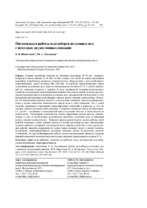| dc.contributor.author | Ивашечкин, В. В. | |
| dc.contributor.author | Медведева, Ю. А. | |
| dc.coverage.spatial | Минск | ru |
| dc.date.accessioned | 2022-11-11T12:01:01Z | |
| dc.date.available | 2022-11-11T12:01:01Z | |
| dc.date.issued | 2022 | |
| dc.identifier.citation | Ивашечкин, В. В. Оптимизация работы водозаборов подземных вод с помощью двухколонных скважин = Optimization of the Operation of Groundwater Intakes Using Two-Column Wells / В. В. Ивашечкин, Ю. А. Медведева // Известия высших учебных заведений и энергетических объединений СНГ. Энергетика. – 2022. – № 5. – С. 451-462. | ru |
| dc.identifier.uri | https://rep.bntu.by/handle/data/122368 | |
| dc.description.abstract | Среднее количество скважин на типичном водозаборе 30–40 шт., мощность погружного насоса обычно 32–40 кВт, из чего следует, что только на одном скважинном водозаборе потребляемая мощность электронасосного оборудования в часы наибольшего водопотребления может достигать 900–1600 кВт. В структуре эксплуатационных затрат скважинных водозаборов доля затрат на электроэнергию достигает 85 %. С учетом требований по снижению издержек и тарифов на воду предприятий жилищно-коммунального хозяйства и водоканалов энергосбережение является актуальной задачей. В статье рассмотрена оптимизация работы водозаборов подземных вод с неравномерной водоподачей за счет применения двухколонных водозаборных скважин вместо типовых одноколонных. Показано, что использование мощных насосов в одноколонных скважинах таких водозаборов приводит к резким снижениям динамического уровня воды в стволе скважины. Это, с одной стороны, провоцирует образование кольматирующих отложений в фильтрах за счет их аэрации, снижает удельный дебит скважины и сокращает интервалы между регенерациями, а с другой – увеличивает геометрический напор погружных насосов и энергозатраты на подъем воды. Рассмотрены теоретические основы определения подачи насосов, установленных в одно- и двухколонных водозаборных скважинах, подающих воду на напорный фильтр станции водоподготовки. Приведен пример сравнительного анализа работы одной рабочей скважины с одним мощным насосом в составе водозабора из двух одноколонных скважин (рабочей и резервной) для покрытия всего графика водоподачи и двух двухколонных рабочих скважин, содержащих по одному менее мощному насосу в каждой колонне. Исследована энергоэффективность указанных насосных систем. В результате расчетов установлено, что при комбинировании работы насосов двухколонных скважин в периоды пиковой, основной и частичной нагрузок годовая экономия электроэнергии составит 33 %. | ru |
| dc.language.iso | ru | ru |
| dc.publisher | БНТУ | ru |
| dc.title | Оптимизация работы водозаборов подземных вод с помощью двухколонных скважин | ru |
| dc.title.alternative | Optimization of the Operation of Groundwater Intakes Using Two-Column Wells | ru |
| dc.type | Article | ru |
| dc.identifier.doi | 10.21122/1029-7448-2022-65-5-451-462 | |
| local.description.annotation | The average number of wells at a typical water intake is 30–40, while the power of the submersible pump is usually 32–40 kW, which means that only at one well water intake the power consumption of electric pumping equipment during the hours of greatest water consumption can reach 900–1600 kW. In the structure of operating costs of well water intakes, the share of electricity costs reaches 85 %. Taking into account the requirements for reducing costs and water tariffs of housing and communal services enterprises as well as of water utilities, energy saving is an urgent task. The article considers the optimization of the operation of groundwater intakes with uneven water supply due to the use of two-column water intake wells instead of typical single-column ones. It is shown that the use of powerful pumps in single-column wells of such water intakes causes a sharp decrease in the dynamic water level in the borehole. On the one hand, this provokes the formation of colmating deposits in the filters due to their aeration, reduces the specific flow rate of the well and shortens the intervals between regenerations. On the other hand, this increases the geometric pressure of submersible pumps and energy consumption for lifting water. The theoretical foundations of determining the supply of pumps installed in single- and twocolumn water intake wells supplying water to the pressure filter of the water treatment plant are considered. An example of a comparative analysis of the operation of one working well with one powerful pump as part of a water intake of two single-column wells (working and reserve) to cover the entire water supply schedule and two two-column working wells containing one less powerful pump in each column is given. The energy efficiency of these pumping systems is investigated. As a result of calculations, it was found that when combining the operation of pumps of two-column wells during periods of peak, main and partial loads, the annual energy savings will amount to 33 %. | ru |

